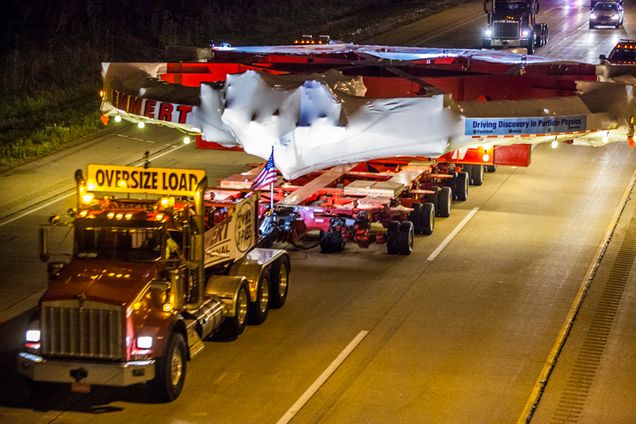Searching the subatomic world for a new force
BU physicists find evidence in the subatomic world that new fundamental property of matter and space
BU physicists find evidence in the subatomic world that new fundamental property of matter and space
For more than 30 years, BU Physics Professors B. Lee Roberts, James Miller, and Robert Carey have been researching properties of subatomic particles, hoping to discover a new force that governs physical interactions.
Now they and their collaborators in a Fermilab experiment called the Muon g-2 have released a new set of results that may indicate the presence of this unknown force. The results, unveiled in a scientific seminar on August 10, are twice as precise as their previous results.
“There are three forces we know about. But many many experiments worldwide are searching for something more than that,” said Roberts, who received the 2023 W.K.H. Panofsky Prize in Experimental Particle Physics from the American Physical Society. “We know that our current theory is incomplete. The question is what else is out there. There are hundreds of theoretical papers speculating on what that might be. Finding something that can’t be explained by the Standard Model is the holy grail of physics.”

The three known forces at the subatomic level are the electric (and magnetic) force, the strong force, and the weak force. Physicists describe how these forces work with a theory known as the Standard Model. By making predictions based on the Standard Model and comparing them to experimental results, physicists can discern whether the theory is complete — or if there is an unknown force beyond the Standard Model.

To search for a new force, Carey, Miller, and Roberts are working with an international group of 200 scientists from 33 institutions to study the movement of muons in a magnetic field, fundamental subatomic particles that are similar to electrons but about 200 times as massive. Their BU team — which also includes two graduate students and two postdoctoral research associates — is one of the leading groups in the Muon g-2 collaboration.
Muons occur naturally when cosmic rays strike Earth’s atmosphere and live for approximately two microseconds — which is “forever” in the world, according to Roberts — making them a good particle to study. And like electrons, they have a tiny internal magnet that, in the presence of a magnetic field, causes the particle to wobble like the axis of a toy top.

To measure the speed of the muon’s wobble, the Muon g-2 collaboration sends beams of muons — created by particle accelerators — into a 50-foot-diameter superconducting magnetic storage ring located at Fermilab in Batavia, Illinois. There, muons circulate about 4,000 times — at nearly the speed of light. Detectors lining the ring allow scientists to determine how rapidly the muons are spinning.
By measuring how fast these muons wobble around in the magnetic field, Carey, Miller, Roberts, and their colleagues are able to determine the strength of the muon’s internal magnet. This number, which can be calculated within the Standard Model, is described by a number that physicists call the “g-factor.” That’s why the research is called the Muon g-2 (gee minus two) experiment.
“Theoretical physicists have calculated the value very precisely, where they have included all three of these known forces in their calculations,” Miller said. “We compare the value we measure in our experiment to the value calculated by the theoretical physicists. If there is a statistically significant difference between the calculated value and the measured value, it would be evidence for a new force in nature.”
Roberts and Miller joined the Muon g-2 collaboration in 1989 at the U.S. Department of Energy’s Brookhaven Laboratory in Long Island. Carey joined a year later as a postdoctoral research associate. In 2004, the group reported the results of their experiment. Subsequently the superconducting storage ring was transported 3,200 miles by air, water, and closed highways to Batavia, Illinois, where they assembled the tools at Fermilab, with improved techniques, instrumentation and simulations, including a new powerful new muon beamline. Based on additional data collection, they published a paper in Physical Review Letters in April 2021 that agreed with the Brookhaven result. That paper has over 1,400 citations from other scientists thus far.


Now they and their colleagues have released a new set of results — the world’s most precise measurement yet of the magnetic moment of the muon.
“How precise is our experiment?” Roberts said. “If the corresponding uncertainty of our measurement of the length of the football field was one human hair diameter, (approximately 0.001 inch), that measurement would have the same precision as our new measurement of the muon g-2 value.”
So far, 40 students have received their doctorates based on their work on the Fermilab experiment, including five from Boston University, and the team’s work has been cited in over 3,200 papers. Collaborators will now spend the next couple of years analyzing the final three years of data.
“When the first result came out it was on front pages all over the world because it looked like we were on our way to a major discovery,” Roberts said. “This new result is twice as precise as our previous result. But the theory is in an uncertain state. We have to wait for the theorists to sort that out.”’
And even though the particle physicists need to wait for reactions from their theorist colleagues, Roberts says the results are the best in the field so far — possibly indicating that there is a new, unknown force, in the universe.
“We get so many citations because the experiment provides a window into the unknown,” Carey said. “I joined the muon g-2 collaboration when my daughter was a week old. She is now an environmental lawyer and is expecting our first grandchild. It has been a decades-long experiment, and we’re so excited to have gotten this far.”
